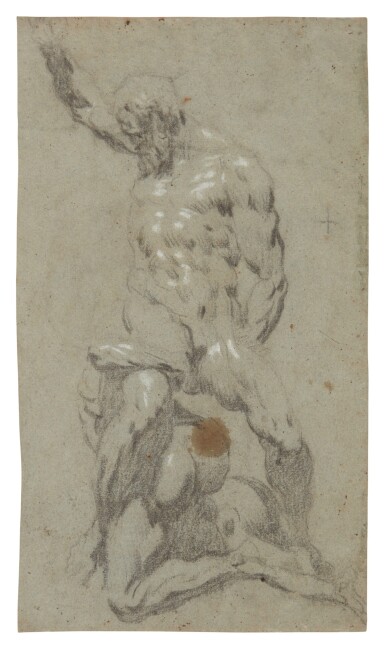Old Master and British Works on Paper
Old Master and British Works on Paper

Workshop of Jacopo Tintoretto
Samson slaying the Philistines, after Michelangelo (recto and verso)
Lot Closed
January 26, 08:24 PM GMT
Estimate
4,000 - 6,000 USD
Lot Details
Description
Workshop of Jacopo Tintoretto
Samson slaying the Philistines, after Michelangelo (recto and verso)
Black chalk heightened with white chalk, on blue paper (recto and verso)
367 by 206 mm; 14½ by 8⅛ in.
Ian Woodner, New York,
his estate sale, London, Christie's, 7 July 1992, lot 15;
with John R. Cassayd-Smith, London,
where acquired by the present owner
Stanford, CA, Art Gallery, The Detroit Institute of Arts, and Finch College Museum of Art, New York, Old Master Drawings from the Collection of Kurt Meissner, Zürich, 1969-70, cat. no. 25, reproduced (as Jacopo Tintoretto)
This is one of over thirty known studies by Tintoretto and his studio after a bozzetto of Michelangelo's unexecuted sculpture Samson and the Philistines, designed circa 1530 for the Piazza della Signoria, Florence as a pendant to David. Although Michelangelo's model does not survive, the sculpture is known from a small group of bronze reproductions. Carlo Ridolfi's biography of Tintoretto states that the artist was given small versions of Michelangelo's Medici Chapel sculptures by Daniele da Volterra, Michelangelo's assistant. It would have been such a replica, or else a clay bozzetto, that Tintoretto used to study.
The sheer number of drawings, their repetitious nature and variations in quality means that deciding which are autograph has proved to be 'a notorious challenge of connoiseurship'.1 Of the twenty-two studies identified by the Tietzes, ten are given to the master himself and twelve to his workshop.2 Rossi is even more cautious, accepting only seven as Tintoretto and one as 'Attributed to'.3
1. Tintoretto, exhib. cat., Madrid, Museo Nacional del Prado 2007, p. 403, cat. nos 55-6
2. See H. Tietze and E. Tietze-Conrat, The Drawings of the Venetian Painters in the 15th and 16th Centuries, New York 1970, pp. 278-303, nos. 1559, 1564, 1566, 1666, 1679, 1707, 1708, 1733, 1734, 1741, 1771, 1772, 1811, 1813, 1814, 1827, 1841, 1842, 1845, 1848, 1860, 1862
3. Those in the Musée Bonnat, Bayonne (inv. no. 3129), the Courtauld Institute, London (inv. no. 99), the Kupferstichkabinett, Staatliche Museen, Berlin (inv. no. 5228), Christ Church, Oxford (inv. no. 0360), the Boymans-van Beuningen Museum, Rotterdam and the two drawings at the Fogg. See Tintoretto, loc.cit., note 3
